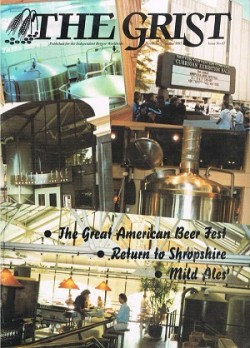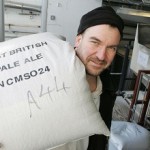The Campaign for Unreal Ale: An Oral History
From the 1970s, the Campaign for Real Ale (CAMRA) dominated the conversation around beer in Britain, and cask-conditioned “real ale” was all but synonymous with good beer.
Then, in the mid-’90s, a band of industry insiders began to question that orthodoxy, suggesting that beer in kegs and bottles, filtered and carbonated before packaging, might be the key to increasing stylistic diversity and overall quality in the UK.
They found their voice through a niche industry magazine called The Grist and especially in the November/December 1995 issue, which amounts to a manifesto for the next 20 years of an emerging UK craft beer scene. Its editor was the young London-born, German-trained brewer Alastair Hook.

Alastair Hook
ALASTAIR HOOK
The Grist was an independent magazine run by Tony Williamson and Elisabeth Baker. When I first set up the Packhorse Brewing Co. in Ashford, Kent, in 1990, they made contact and said they’d like to do a feature. The magazine was their passion.
PETER HAYDON
(contributor to The Grist, beer historian and brewer)
In 1994, I’d just published my book, The English Pub, and Lizzie was looking for someone to help Tony, so I became a sort of freelance jobbing journalist contributing articles. When Tony became ill, Alastair stepped into the editor’s chair and changed the magazine’s direction. He was evangelical.
MARK DORBER
(staff/manager/landlord at the White Horse, Parson’s Green, 1981 to 2007)
In 1994, Roger Protz suggested I should talk to Alastair Hook. I spoke to Alastair on the phone and got on well and then met at a pub in Greenwich and spent Sunday afternoon drinking and talking. We shared the same beer values—we wanted to get people looking internationally rather than being narrowly parochial. We had a very strong feeling that the UK beer scene needed shaking up.
ALASTAIR HOOK
When I was 17 or 18, I was very gung-ho about CAMRA—cask ale was the be-all-and-end-all, all that—but by the mid-90s, I’d lost my fascination. The editorial line at The Grist became more and more critical of CAMRA. The more dogmatic they became, the more we reacted against it.
MARK DORBER
We love cask ale–we adore it, and I made a career out of it–but what we were critical of was the idea that, if it wasn’t cask, it couldn’t be worth drinking. That all-or-nothing mentality was a negative drag.
PETER HAYDON
We took the view that the British brewing industry had failed to represent itself. If a journalist wanted a comment on something beer-related, they went toddling off to CAMRA. If you had a story about roads, you wouldn’t go to the Reliant Robin Owners Club, would you?
A particular bone of contention was the “cask breather,” a device that allows traditional casks to work in their usual way except that, instead of permitting air to enter as the cask empties, it fills the void with a light blanket of carbon dioxide, extending the life of the beer.
MARK DORBER
CAMRA’s refusal to support the use of cask breathers made them seem, to us, like inhibitors of change. If your pub was found to be using cask breathers, you were seen as being somehow not a true supporter of cask beer, which is ridiculous.
ALASTAIR HOOK
Oxidation kills flavor, and the idea that oxygen improves beer is just absurd.
PETER HAYDON
CAMRA would rather you drank shit beer as long as it was “correctly” dispensed.
MARK DORBER
I first went to judge in Denver in 1992. By 1995, it was certainly where all the thoughtful English beer people were going. Being on those professionally run blind-tasting panels with like-minded people eager to explore tradition, eager to explore flavor—the best of your peers in the world—was hugely uplifting. There was a buzz, a sense of energy, of unbounded optimism, a feeling that anything was possible.
Vibrant flavours stood out in many of the beers judged and sampled. (Alas, much of the UK brewing industry, by contrast, seems reluctant to offend any portion of the beer market with its bland {aka ‘balanced’}] beers.) (Mark Dorber, “An Uplifting Experience,” The Grist, Nov/Dec 1995.)
ALASTAIR HOOK
From those American trips, I learned that tasty, flavorful, consumer-attractive, choice-providing beer didn’t have to be cask-conditioned.
American microbrewed beers are rich in character, flavor, diversity and in the case of the more successful micros, consistency… CAMRA take the credit for revitalising the magnificent art of cask conditioned ale brewing, but they fail to see how their puritan approach is a threat to the emerging microbrewing scene. (Alastair Hook, “All guns blazing in the USA,” The Grist, Nov/Dec 1995.)
MARK DORBER
Meanwhile, in the UK, micros seemed to lack aesthetic judgement. … They weren’t interested in keg or bottle, only in paying homage to the great god of cask-conditioned beer.
For the small brewer to survive, a quality product is needed at the point of dispense, albeit from a cask with or without the breather, bottled or, dare I say, filtered and kegged. (Keith Lark, Hook’s former schoolteacher, under the pseudonym Keith Laric, “Thoughts of a Beer Drinker,” The Grist, Nov/Dec 1995.)
JOHN CRYNE (Chairman of CAMRA 1989-98)
What Mr. Dorber and his cohorts may have done in 1995 must have passed me by; clearly the ripples they intended to create were something of a damp squib. … Judging by the plethora of U.S. beer styles, presumably they won their argument and CAMRA lost. Oh wait a minute—CAMRA has a 170,000 members and The Grist has presumably gone to the mill?
PETER HAYDON
It was a bit ahead of its time—there weren’t really the number of breweries around then to support it with advertising—but it was a bloody good little magazine.
Alastair Hook founded Meantime Brewing in 1999; it was taken over by SAB Miller in May 2015. Peter Haydon succeeded Alastair Hook as editor of The Grist, which ceased publication in 1998, and now owns a brewery in South London. Mark Dorber now runs the Anchor at Walberswick and was a co-founder of the Beer Academy. The conversations with Dorber, Haydon and Hook were carried out over the phone; John Cryne corresponded by email.
Boak and Bailey have been blogging at boakandbailey.com since 2007. They were named 2014 beer writers of the year by the British Guild of Beer Writers for Brew Britannia: the Strange Rebirth of British Beer. They live in Cornwall in the far west of the UK.




While at the Morning Advertiser (1986-92) I got to know Tony and Lizzie extremely well and was based at the Grist’s “secret headquarters” in Balfour Road for much of 1993. Their passion was more for the welfare of their family of microbrewers than for ideological battles over methods of dispense, and I think it was this focus that laid the foundations for SIBA’s success. I have to say that after joining What’s Brewing in 1994 I was completely unaware that Peter and Mark had any particular position on cask v keg; certainly from the various events I attended at the White Horse I never got the impression that Mark had any time for keg at all. But perhaps I was just being obtuse. In those days Alastair was a bit of a lone voice crying in the wilderness (well, him and Oliver Hughes), and the first crop of keg-oriented micros such as Mash & Air didn’t seem to make any lasting impact. One point worth making, though: Camristas who wouldn’t be seen dead drinking keg beer at home were only too overjoyed to do it in Belgium and Germany, and the casuistry and contortions they adopted to justify their double standards were hysterically funny!
I take it the John Cryne statement is a recent one given the quoted membership number.
Is he blind to the changes that are occurring _now_? To the _growing_ plethora of US-inspired beers on the market in all formats, to the new-wave creativity becoming the standard for new UK brewers and old breweries with their fingers on the pulse. To the rapid growth and adoption of keg beers?
I’d say folk like Mark, Alastair, and Peter really have paved the way for the direction in which UK brewing is currently heading. And they’re still here, still in the industry, still pushing ahead. “Grist” may have gone away, but the people simply invested their energies elsewhere in directions that made real difference to the industry. (I’d argue the Beer Academy is a bigger achievement than Grist could have been.)
As for membership numbers. Sure, an increasing number of folk shell out for membership. But I don’t see an increasing number of folk actually *campaigning* at the grass-roots level. And many of those I do know are as in love with great modern/US beer styles as they are with great traditional cask ales and are quite often puzzled by the seeming overall direction and ethos of the organisation they’re a part of. (I am one of several active members I know who’ll be parting ways with CAMRA this year, this is of very little importance or impact individually mind you, but I see CAMRA losing a lot of good technical/grass-roots beer volunteers at the moment. In favour of picking up what sort of members…?)
As Yvan hints, John Cryne is being entirely disingenuous in parading Camra’s membership numbers as alleged proof that its line is correct and the Gristites were wrong. Camra’s membership is so large solely because of ‘direct debit inertia’ – you sign up to have your membership fee taken from your bank acount and you can’t be arrised to cancel it. It would be just as valid to claim that the Grist line has been proved correct because AlastairHook is now a multi-millionaire and John Cryne isn’t …
I think CAMRA these days basically stands for the position stated here by Mark Dorber – cask beer is basically a good thing, worth campaigning for & worth preserving where it’s under threat, but there is great beer out there that’s not cask. As Ted says, anyone who thought otherwise would have a rude awakening on their first trip to Belgium.
The anti-cask position taken by Alistair Cook & a few others – well, nobody can say it hasn’t led to commercial success, but there isn’t any kind of groundswell of anti-cask opinion. Mostly people don’t care that much about what state their beer reaches them in, and almost all of those who do care are on CAMRA’s side of the argument.
As a member (as I then was) I attended CAMRA’s AGMs in Torquay in 2012 and Norwich in 2013. The same arguments were batted back and forth by various die hard greybeards about cask v keg and craft v ‘real’. The best and most telling insight came from NE member Christine Cryne who canvassed opinion in the hall at Norwich. “Of all of you here, how many of you have drunk craft beer this year?” Nearly every hand went up. And then she said “this is the Campaign FOR Real Ale, not a campaign AGAINST anything else. We champion the making and drinking of traditionally brewed beer, and pubs to serve it in.” The two styles can happily coexist, as long as they are worth drinking. It’s a non-argument in my view. Good beer is good beer; if you like the taste of it, drink it. I spent 2 weeks last summer in Traverse City, Michigan home to 9 microbreweries making craft beer and 250k permanent residents. I drank nothing but ferociously hopped strong beers for 14 days straight and came home with a lifelong passion for new, hoppy craft beers and trot into BrewDog as often as I can manage. Some of my favourite old standards failed me for a week or two after I came home while my taste buds recovered from all that hop oil but returned eventually. For professional reasons I am today reading the Cask Report 2015 and SIBA’s Beer Report 2015 which make heartening reading. After so many years of decline, beer- especially craft beer- is on the up. There can be no doubt that craft beers are inspiring the younger drinker, male and female. And they are the long-term future of British brewing. They are establishing themselves as customers for life. Once turned on to beer as a drink, they experiment with other beers including traditional cask ales. We’re all in this FV together chaps- let us celebrate beer’s diversity, it’s a big enough tub for all of us. There’s room for everyone, and every style. Well maybe not the chilli infused monstrosity I tried a few months back purely out of curiosity, but nearly all. There is no need to lob ideological hand grenades over each other’s walls. Dale (CAMRA CotY 2013 – now ex-member- beer lover and worker with pubs, publicans, campaigners and breweries).
Another article piggybacked onto the anti-CAMRA ‘establishment.’ CAMRA is not there for anything other than making sure the traditional real ales of Britain don’t disappear. They have a massive membership and massive influence. Every upstart begins by slagging CAMRA off, like they’re breaking new ground, often including (see above) inevitable references to age and gender. Many succeed based on the strength and prowess of CAMRA (can you say Brew Dog) but please, get your own gig. As Leonard Cohen once said, ‘Let’s sing another song, boys … this one has grown old and bitter.”
“piggybacking onto the anti-CAMRA ‘establishment’” … oh, Phil, please. What are you on about? Camra has a large membership – not massive, “massive” would be something five times Camra’s size – of which more than 98% do nothing active at all. BrewDog would have been a success whether Camra existed or not. And Camra had better try to appeal to the craft beer drinkers without alienating them, as it often does at the moment, because as Dale points out, young craft beer drinkers are the future of all good beer, cask and non-cask.
Good timing — just after CAMRA’s brilliantly successful Great British Beer Festival, attended by more than 50,000 people. The annual Cask Report, produced independently of CAMRA, says that cask beer outsells both old-fashioned keg beer and new craft keg combined. I was at the Peterborough beer festival on Friday, second biggest CAMRA fest after GBBF, and was pleased not only by the large crowds but by the high proportion of young people attending.
I have some old copies of the Grist: I will have to reread them as I wasn’t aware of its prescience. Mark Dorber and I worked together on an IPA and Pale Ale seminar in London in the 1990s that helped kick-start the IPA revival: Mark was a passionate devotee of cask beer and led the way in ensuring that it was stored and served correctly.
In my opinion, CAMRA was wrong about cask breathers and it’s no longer an issue. It now supports such developments as key casks and pubs such as Zerodegrees that serve beer from tanks, not casks.
CAMRA is not hostile to new developments in the brewing industry. As Christine Cryne has said: “Anything that draws people into drinking good beer has to be welcomed”. A major strategy review is underway to develop the Campaign’s attitude to a changing beer scene. It acknowledges the fact that some outlets, such as modern bars and restaurants, are not able to store cask beer.
More than 200 new breweries have opened in the past 12 months, the majority producing cask beer. I am delighted to see so many new beer styles being made. Some are craft keg and are excellent but the statistics speak for themselves — the big success story in Britain is cask.
Let us as lovers of good beer rejoice in the exuberant and innovative beer scene and unite against the real threat, which comes from the global brewers.
I don’t have a problem with CAMRA – I don’t think about it. It’s irrelevant. What was strange was when I gave a talk at the Great British Beer Festival but my own beer, from Meantime, got stopped at the door by some jobsworth who wouldn’t have it on the premises because it wasn’t real ale.
One of the things that got lost in the mix was a point I had tried to make concerning CAMRA’s early championing of US beer styles at its Great British Beer Festival – in 1985 in Brighton. 10 years before this Grist piece. At the behest of brewers in the Pacific NW, I visited that area. This led to a contingent of brewers and their beers, led by the legendary Bert Grant, coming to the UK. This included beers from Columbia River Brewery, Widmer Brewing, Hart Brewing, Independent Ale Brewery, Kemper Brewing, Mountain Ales and Bert’s own Yakima Malting & Brewing Co. Imperial Stout, voted best beer at the ’84 Great American Beer Festival.
I’m trying to trace the whereabouts of Elisabeth Baker. I was a close friend of both her and Tony Williamson but lost touch with them about 2000. Do any of you guys have a clue as to where she is now?